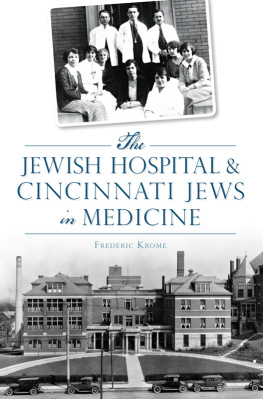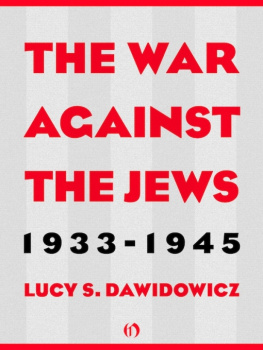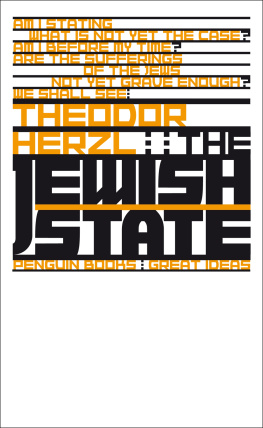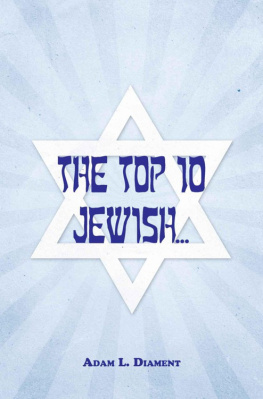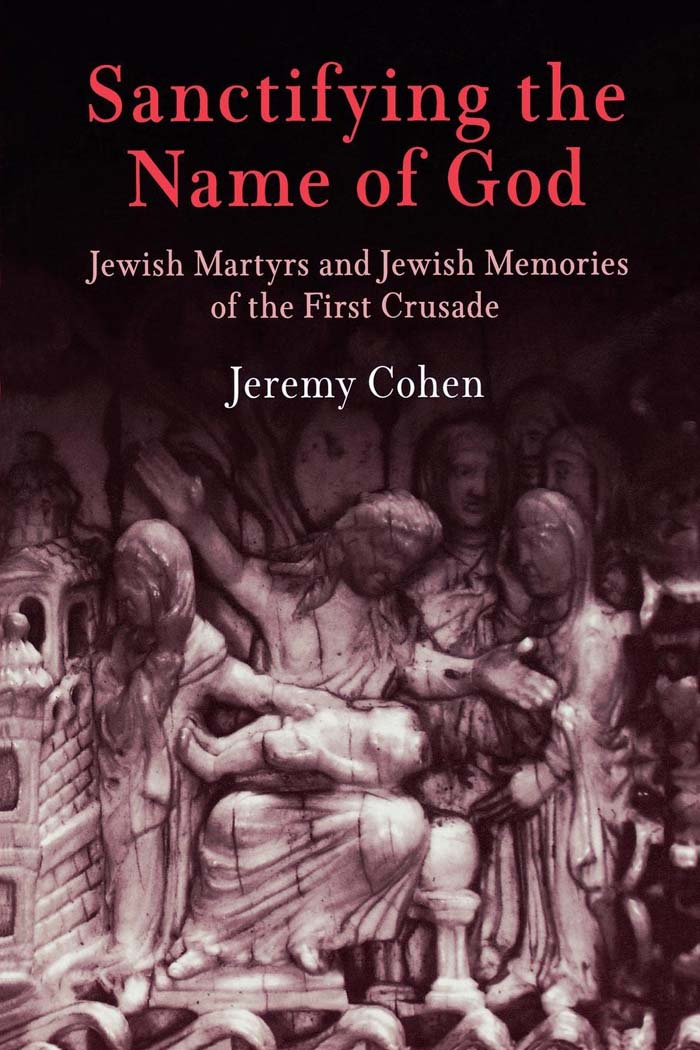Sanctifying the Name of God
JEWISH CULTURE AND CONTEXTS
Published in association with the Center for Advanced Judaic Studies
of the University of Pennsylvania
David B. Ruderman, Series Editor
Advisory Board
Richard I. Cohen
Moshe Idel
Deborah Dash Moore
Ada Rapoport-Albert
David Stern
A complete list of books in the series is available from the publisher.
Sanctifying the Name of God
Jewish Martyrs and Jewish Memories of the First Crusade
Jeremy Cohen
PENN
University of Pennsylvania Press
Philadelphia
Copyright 2004 University of Pennsylvania Press
All rights reserved
Printed in the United States of America on acid-free paper
10 9 8 7 6 5 4 3 2 1
First paperback edition 2006
Published by
University of Pennsylvania Press
Philadelphia, Pennsylvania 19104-4112
Library of Congress Cataloging-in-Publication Data
Cohen, Jeremy, 1953-
Santifying the name of God : Jewish martyrs and Jewish memories of the First Crusade / Jeremy Cohen.
p. cm. (Jewish culture and contexts)
Includes bibliographical references and index.
ISBN-13: 978-0-8122-3780-1 (cloth : alk. paper)
ISBN-10: 0-8122-3780-3 (cloth : alk. paper)
ISBN-13: 978-0-8122-1956-2 (pbk. : alk. paper)
ISBN-10: 0-8122-1956-2 (pbk. : alk. paper)
1. JewsGermanyHistory1096-1147. 2. JewsPersecutionsGermany. 3. CrusadesFirst, 1096-1099. 4. GermanyEthnic relations. I. Title. II. Series.
DS135. G31C64 2004
943. 004924 dc22 | 2003069063 |
Contents
Preface
Students of literature, anthropology, and psychology have long taken for granted that a historical story does not reflect the world of the (historical) characters who function within it but the world of the people who tell it. Some consider this truth so self-evident that they refer to it as a banal fact. Yet, for some reason, we continue to expect more from the field of history and from the historian. We naively hope and assume that they can penetrate the impenetrable, break through the stories recording the past, and accurately reconstruct the events of their narrativesobjectively, as it were, free of all editorial interpretation and distortion. Paraphrasing one of the doyens of historical research during the heyday of nineteenth-century positivism, we expect historians and their craft to tell us how it actually happened, not much more, and certainly nothing less. Most nineteenth- and twentieth-century historians promoted this notion of their mission, and they confidently turned their energies toward pursuing it.
Historians of the last generations, however, have gradually acknowledged the futility of attempting to isolate the events of history from the many layers of their subsequent memories, especially as we realize the magnitude of our investment in the past. Paradoxically, the more we need to reconstruct our history, the more the goal of filtering facts out of their interpretation eludes us. Human nature does not allow for transmitting information entirely objectively, and it never did. A reported event by its very nature has always been an interpreted event. No matter how close to an event historical sources might be, they still convey human memories of what transpired, memories that derive from very much more than that past event itself. One can never travel the entire distance between text and event, a distance compounded at every stage of the transmission of historical information, for its transmitters inevitably reinterpret as they convey it onward.
With such considerations in mind, this book struggles with tales of Jewish martyrdom from the First Crusade, when Jews of northern Europe, attacked by bands of crusaders, met a violent death to avoid conversion to Christianity. These anti-Jewish persecutions of 1096or Gezerot Tatnu as Jews remember them in Hebrew and the present investigation will seek to make this critical chapter in medieval Jewish history more accessible to a broader readership, at the same time as it offers a different perspective on the events and their memories.
In the first instance, this book will investigate the reactions of the Jews attacked by the crusaders in 1096 and, most directly, the memories of those reactions that lived on among the survivors. Our interest lies primarily with stories told by the survivors and with the role, the significance, of these stories in the Jewish society that produced them. How did Jews in twelfth-century Germany remember and memorialize those who preferred death as a Jew to life as a Christian? What historical and cultural circumstances gave rise to these memories of martyrdom, as opposed to the events that they narrate?
Additionally, this book will read tales of medieval Jewish martyrdom in a manner that few have tried and developed. As the opening years of the twenty-first century have reinforced upon us, communities remember their martyrsand choose to identify them as martyrs in their memoriesbecause they died for ideals that these communities of the living cherish. When we label past victims of violence and persecution martyrs, we give expression to heavy emotional baggage that we presently carry with us. While tales of martyrdom, then, perhaps can teach us something about the martyrs themselves, their ideas, and their deaths, they communicate considerably more about the martyrologists, those who remember the martyrs and tell their stories because they find them meaningful. Applying these principles to the extant Hebrew narratives of the 1096 persecutions, we shall see how the martyrs stories teach us above all else about the survivors who told them. These twelfth-century accounts of the violence and victims of 1096 demonstrate how those living made sense of the self-sacrifice of the dead, and how their memories gave expression to the needs and circumstances of European Jews during the decades that followed.
During the years I have worked on this book, many have found its ideas unsettling; some have even responded to them out of fear or anger. As we shall see, the example of the Jewish martyrs of 1096 nourished the idealism of Ashkenazic Jews ever since, and the greatest of twentieth-century Jewish historians drew direct connections between Jewish martyrdom during the Crusades and the extermination of Jews during the Holocaust. Cherished memories surely heighten the sensitivity and zeal with which we react to Holocaust deniers, particularly after historians have justly triumphed over deniers in courts of law. Suggesting that tales of martyrdom in our Crusade chronicles might not amount to totally accurate, factual reporting, that they express an ideology of martyrdom that belonged to the living survivor, not the slain martyr, I have appeared to some as treading dangerously close to the borders of revisionism.
Let me, then, clarify my stance in this book, as succinctly as I can: Revisionist in the traditional, scholarly sense of proposing a fundamentally new interpretation? Invoking Yale historian Donald Kagans statement that by revisionist we refer to a writer who tries to change the readers mind about events in the past in a major way, I readily confess my revisionist aspirations. Must our conclusions and our method undermine the historical truth of the events of martyrdom, during the Crusades, the Holocaust, or at any other time? Absolutely not. Nevertheless, they demonstrate that the historian must recognize and struggle with the complex relationship between event and text. The attacks of terrorist martyrs on the World Trade Center and the Pentagon just several years agosuicides who died resisting what many Muslims identify as a new, modern-day Western crusadeunderscore the critical importance of the historians task: to understand how cultures endow events with their meaning. Watching the news media daily, particularly in the Middle Eastern setting where I have written my book, we see how one persons martyr is another persons villain. Now more than ever, we must distinguish between martyrs and their memories as responsibly as we can.





